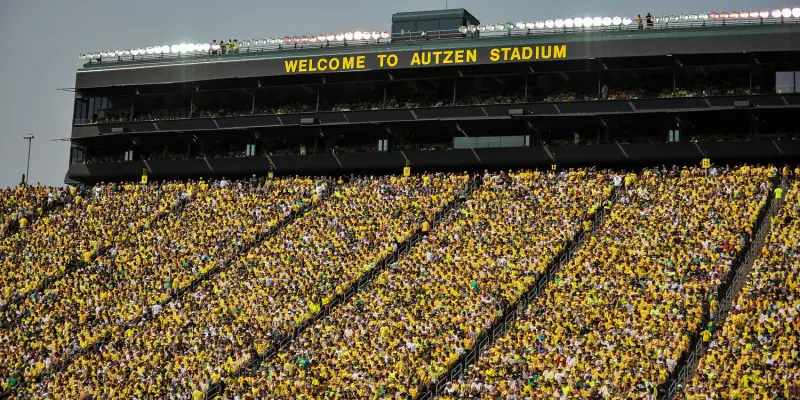Mike Merrell’s Three-and-Out
The University of Oregon Senate has proposed a 3 % “tax” on the Athletic Department (A.D.) to help fund general University expenses. ESPN’s Ted Miller likens reluctance to go along with this idea to a 12-year-old child actor getting $10 million and not wanting to share it with his parents while living under the same roof.
It is true that the A. D. falls under the overall University structure and certainly benefits from the relationship. Beyond that, Ted’s analogy breaks down in a hurry. Why the University Senate’s proposal to go after A. D. funds is a bad, bad, bad idea is the subject of this week’s Three-and-Out.
1. The University’s History of Abuse. If the University is the parent and the Athletic Department is the child, then this family has a history of child abuse. When Autzen Stadium first opened in 1967, all students had to do to get into a game was flash their student body cards. This was because a generous portion of the student body funds supported the AD.
By 1969, in true socialist fashion, the Student Senate had the idea that student body funds dedicated to supporting athletics were “benefiting the few” and should be curtailed. I personally attend a Student Senate session and testified that if they believe all funds should be shared equally, then instead of helping finance a marching band, they should just buy every student a kazoo.
Mental giants that they were, they virtually took my advice, because it was only a few years later that Oregon had no marching band. So much for the pursuit of excellence. So much for creating anything special. The 15,000 who bothered to show up for football games presented by a vastly under-financed athletic department were treated to a small amplified rock group belting out “Mighty Oregon” over the field speakers — while the Ducks’ football team got belted by whatever other team showed up to play. And I never did get my kazoo.
The Student Senate, along with most other potential University supporters, basically told the A. D., “Kid, you’re on your own.” And it was at a time when the A. D. truly was not ready to be on its own. As a result of decreased support — and the passage of Title IX, which created the financial demand of equal opportunity for women’s sports — the A.D. was forced to drop swimming, gymnastics and wrestling (that I know of) as sports — as well as field fairly pathetic teams across the board.
The State Legislature has treated the Athletic Department no better. According to a recent article in the Register Guard, the UO Athletic Department gets a measly 2 % of its support from the University — compared to a national average of 11 %.
But of course the State Legislature’s lack of support isn’t just for Oregon athletics. It stretches to the entire University. Of the 62 members of the prestigious American Association of Universities, the University of Oregon ranks dead last in state funding. This endangers the UO’s continued membership in the organization and may eventually lead the school to become a completely private institution.
So, admittedly — due to the State Legislature placing little value on education — the University is in a tight spot financially, and looking toward the lucrative athletics may on the surface appear to be an attractive solution.
The problem, though, is that the University’s overall annual budget is $905 million and with the athletic budget at only about one-tenth of that amount, there is a real limit to how much the University could suck out of the A.D. without destroying it, as it was nearly destroyed in the 1970s. It is simple math that $3 million means a lot more to a $90 million budget than it does to a $900 million budget. About ten times as much. But this is probably more obvious to the faculty’s accounting department than it is to Sociology Assistant Professor Michael Dreiling, an outspoken proponent of the idea.
2. The Athletic Department already benefits the University financially. And it does so in so many ways that quantification of the value is impossible. Certainly, the A.D. has brought the University national exposure that attracts profitable out-of-state students — and with the pathetic funding that the State Legislature provides the University, out-of-state students’ tuition is an important part of the financial equation.
By my calculations, the A.D. pays the University about $11 million per year in scholarships — and 84 % of the scholarship athletes are out-of-state (= profitable). Add to this the money that walk-ons and athletes receiving partial scholarships pay in out-of-state tuition. Then add the out-of-state tuition from non-athlete students who are drawn to the U of O because of athletics.
Then add the money donated to the University by people whose ties have been strengthened because of Oregon Athletics. It’s probably impossible to put a number on this, but the Knight Library comes to mind, for starters.
Taking money out of the Athletic Department will only weaken its ability to continue to provide these benefits to the University. Picture only 15,000 people showing up for a game at Autzen — as was the case in the past. What effect would that have on the financial benefits described above?
3. Whatever happened to pursuit of excellence as a goal? Certainly some control over athletic expenditures to keep up in the arms race is in order, and this would be a good topic for the NCAA to address so that all are affected equally. But making an athletic department serve as a profit center for its university would only compound the problem, because it leads to the idea that only “profitable” sports should be sponsored.
In an era when the U.S. is becoming more obese and couch potato-ish by the day, we need the focus on physical excellence. A well-rounded slate of intercollegiate sports providing both opportunity and inspiration is part of the solution.
The NCAA sponsors 23 different sports, most of them for both men and women. Oregon fields teams in only seven sports for men and eleven for women — and that’s counting tumbling and sand volleyball, which aren’t on the NCAA’s list. That’s leaving a lot of opportunity for promoting athletics on the table.
Now that the A.D. is back on its feet financially — and this did not happen because of valuable input from sociology professors — it is in a position to start promoting athletic excellence in swimming, water polo, gymnastics, wrestling, men’s volleyball and soccer…. the list goes on. And in doing so it would broaden its promotion of athletic ideals and provide opportunities to a more diverse group of athletes.
The root of the University of Oregon’s financial problem isn’t the Athletic Department, which already adds to the University’s financial success immeasurably. The problem is tightwad funding by the State Legislature. The idea that the A. D. should have its throat cut to make up for the Legislature’s failure is not the same as expecting a twelve-year-old movie star to share the wealth. It’s more like leeching off your grown children — who succeeded in spite of everything you did — when you could darn well take care of yourself.
Top photo by Kevin Cline
Related Articles:
Chip Kelly Update: Everything's Good Again ...
Chip Kelly Update: Wailing and Gnashing of Teeth
Shock and Awe -- The Oregon Ducks' Football Hangover Effect
Despite Lopsided Score, Georgia State "Never Stopped Believing"
Hope Springs Eternal for Ducks
Incompetent Pac-12 Officials: How Do You Miss ALL of THIS?
Mike (Editor-in-Chief) is a 1970 graduate of the University of Oregon where he attended the Honors College and received all-conference honors as a swimmer. After college, Mike ran for the Oregon Track Club and narrowly missed qualifying for the US Olympic Trials in the marathon. He continues his involvement in sports with near-daily swimming or running workouts, occasional masters swim competition (where he has received two Top-10 World rankings), providing volunteer coaching to local triathletes and helping out with FishDuck.com.
Mike lives on 28 acres in the forest near Sandpoint, Idaho, where he has served as a certified public accountant for most of his working career. His current night job is writing novels about Abby Westminster, the only known illegitimate daughter of Britain’s finest secret agent who has to bring down arch-villains plotting dastardly deeds. And, yes, Abby is also a DUCK!





